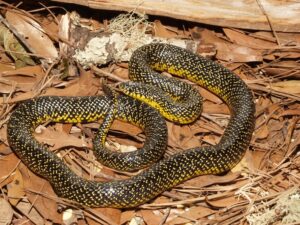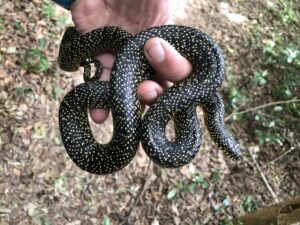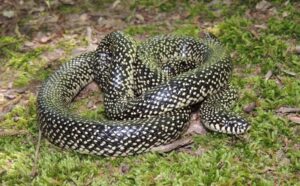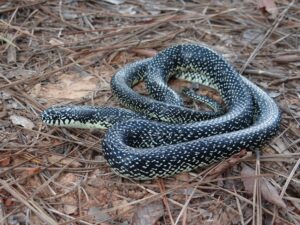The nonvenomous speckled kingsnake is endemic to the US. Because of their black-and-white pattern, they are alternately referred to as salt-and-pepper snakes.
John Edwards Holbrook, American herpetologist, and zoologist, first described this species in 1842. He initially referred to it as Coronella sayi since he thought this was the same species Hermann Schlegel described as Coluber sayi. Later, in 1902 American herpetologist Leonhard Hess Stejneger pointed out that the name sayi could not be implemented since Pituophis catenifer sayi is a different snake altogether. He proposed Lampropeltis holbrooki in honor of Holbrook. The speckled kingsnake was a subspecies of the common kingsnake for several years, after which it became an individual species.
Scientific Classifications
- Suborder:Serpentes
- Family:Colubridae
- Genus:Lampropeltis
- Species:L. holbrooki
Conservation Status
Description
Size
They are 36-48 inches long including tai length. However, the recorded length of the speckled kingsnake is as much 72 inches.
Color and Appearance
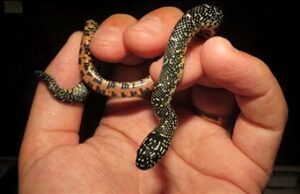
They have a shiny black body marked with tiny yellowish-white spots in the middle of most dorsal scales. The speckled appearance of these scales results in their common name, Speckled kingsnake. They also have a yellowish belly with rectangular-shaped black markings. The juveniles look a little different than their adult counterparts. The spots appear lighter and are arranged on the back, resembling crossbars.
Are They Dangerous to Humans
These docile non-venomous snakes are harmless to humans. If agonized or threatened, they shake their tail, expel feces or musks, and may even bite their predators to defend themselves.
Speckled Kingsnake at a Glance
Distribution
The speckled kingsnake inhabits the central and southern US. They occupy parts of New Mexico, Texas, Arkansas, Kansas, Colorado, Nebraska, Missouri, Iowa, and Louisiana.
Habitat
They have a diverse habitat occupying moist habitats like rivers and swamps, grassy fields, woodlands, rocky ledges, hillsides, and forest areas.
Predators
The eggs and young of the speckled kingsnake are more susceptible to attacks by birds of prey, certain carnivorous mammals, and bigger kingsnake species.
Diet
They feed on small birds, mammals, rodents, frogs, and some venomous snake species like rattlesnakes, copperheads, and cottonmouths. It uses the technique of constriction to capture and kill its prey by coiling around the victim’s body and squeezing it to death.
Reproduction
The mating and courtship of speckled kingsnakes occur between late April and May. The females deposit the eggs from May to June that hatch from August-September. Each batch contains between 6 and 23 eggs.
Similar Species
They lack the salt and pepper look of the speckled kingsnake. Instead, they have yellowish crossbands running through their body, forming a chain-like pattern.
Pet Care Sheet
Enclosure
If your speckled kingsnake reaches its maximum length of 72 inches or 6 feet, the enclosure size would be 4 feet long, 2 feet wide, and 2 feet high. They are good at escaping, so make sure their dwellings have glass sliding doors.
Substrates
Aspen shavings, kitchen rolls, and newspaper are some preferred substrates.
Temperature
The preferred temperature for these snakes is 84-90 °F in the day and 68-75 ° F at night.
Humidity
The average humidity requirement is 40 to 60%.
Source
classdat.appstate.edu, jonathansjungleroadshow.co.uk, inaturalist.ca, louisianaherps.com

